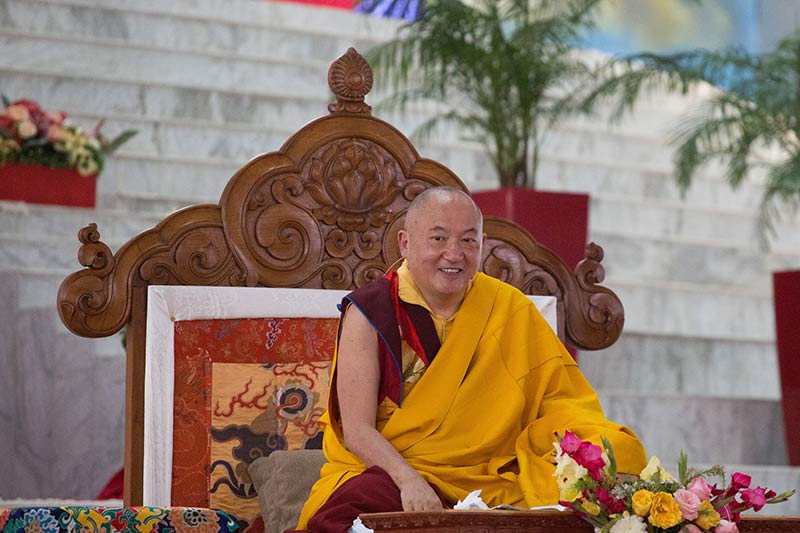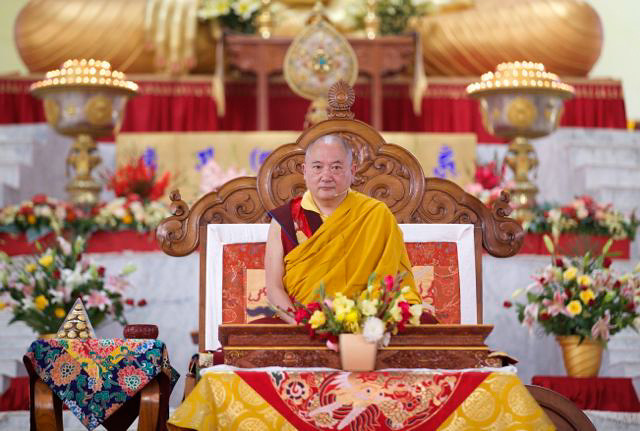
Today, Rinpoche began his commentary on the section in Karmapa Rangjung Dorje’s text specifically aimed at mahāmudrā practitioners, detailing the aspirations for the realisation of mahāmudrā. These verses cover the actual practice for the practitioner: establishing the unmistaken view of the fundamental nature, general conduct of meditation, and how to practice mahāmudrā meditation.
As the latter section of these verses is practice oriented, Gyaltsap Rinpoche emphasised repeatedly the necessity for students of mahāmudrā to receive individually tailored instructions from a qualified teacher.
The aim of a mahāmudrā practitioner must be to establish the correct view, and the first few verses in the section (p.355 Kagyu Monlam Book) concern eliminating exaggerations about mahāmudrā, the nature of the mind: both the misconception of a permanent self and the misconception that the mahāmudrā is either a thing or is void and empty. Rinpoche elaborated:
We sentient beings cling to things as either existent or non-existent. We need to eliminate this clinging. It is a confusion. For this reason, Nagarjuna and other scholars negated both existence and non-existence. If we can eliminate both of those, we will be able to understand the nature of both the ultimate and the relative…and we will have the certainty of the view. The certainty of the view brings joy in knowing …Sustaining that view without distraction is the point of meditation.
In meditation we should not be distracted by our thoughts, nor should we block our thoughts, thinking of nothing at all, which leads to complete unknowing, worse than ignorance. “Whatever arises – thoughts, appearances, sounds, forms –we rest in the confidence of mahāmudrā. That is the point of meditation,” he explained.
We train in the conduct of mahāmudrā to aid and increase the power of our meditation. The tantras teach many different types of conduct such as reciting mantras, using a damaru and bell, wearing robes, but they themselves are not important except as a way to strengthen our meditation by increasing our meditative concentration.
The text now presents an explanation of the mind as the ground of samsara and nirvana. The section begins:
All dharmas are the mind’s manifestations.
The mind: there is no mind; it is empty of mind’s essence.
Empty, it is unceasing, and can appear as anything.
Because we fail to realise this, we are confused, and, as Rangjung Dorje states, we mistake self-appearance as an object and self-awareness as a self. From this mistaken view we develop self-clinging, which is the root of samsara. From self-clinging arise attachment and aversion, and the many afflictions of pride, envy, wrong views and so forth. Because of these afflictions we accumulate karma; consequently we experience samsara and the three types of suffering. For that reason whether you hold the Mahayana or the Mind-Only view, the basis of samsara is the mind, and that is why, when we meditate on mahāmudrā, we first examine the nature of the mind. Where is it? What is it like? Is it a composite or non-composite? Does it have a beginning and an end? When we meditate and cannot find anything, this is a sign of successful meditation.
Some people suggest that the mind does not exist, that it is void. This can be refuted because when we are not aware of the mind’s true nature, we accumulate karma and wander in samsara through the twelve branches of dependent arising. On the other hand, the peace of nirvana also arises from the nature of the mind. Listeners and pratyekabuddhas are able to achieve nirvana because they partially realise the nature of the mind. But only when the nature of the mind is fully manifest do we achieve the four kayas of the Buddha. Rinpoche commented further:
The mind is neither something nor is it nothing. These are not contradictory: the nature of the mind is not an existent eternal self, this is non-existent, but it is also the nature of all phenomena so it is not anything either. It is these two in union. It is the middle way that does not dwell in any extreme.
As the text says: May we realise the mind’s nature, beyond extremes.
How then can we realise the ultimate nature? The Buddha gave it many names —emptiness, the ultimate nature, co-emergence— as a skilful means to help people understand. We should first of all contemplate these names and thereby we are able to reveal the ultimate nature, but then there is nothing to illustrate or indicate it, because, ultimately, the nature of the mind is beyond concepts and cannot be described. Through names and words we can arrive at the ultimate nature which is beyond names and words.
However, as sentient beings our minds arise from the cause of ignorance and cannot realise the ultimate nature. Only by eliminating ignorance can we realise the ultimate nature by using the antidote of the aware primordial wisdom.
As the text says:
Not realising this we circle in samsara
If this is realised, buddha is not elsewhere.
Everything is this, there is nothing that is not this;
May we know dharmata, exposing the all-basis.
This teaches how emptiness and relative interdependence are unified. “The difference between buddhas and sentient beings is whether they are aware or not,” Rinpoche stated. A sentient being is unaware, a Buddha is aware. “All the afflictions, the five poisons all the intentions for committing malice in samsara are, by nature, mahāmudrā.” When we enter the path, and meditate on the true nature, that which we meditate upon and that which meditates upon it are both mahāmudrā.
All the teachings of the great masters, all the miracles, going forth as a nun or monk, all are the nature of mahāmudrā. Other than the dharma expanse, there are no phenomena at all. In this instance, the all-basis, the ālaya, means the nature of mind. The text goes on to say that “all appearances are mind”; emptiness is also a manifestation of mind. All confusion and delusion are also in essence mahāmudrā. There are many methods to eliminate these misconceptions, Gyaltsap Rinpoche advised. Then we should begin mahāmudrā meditation.
The next section of the teaching introduced the methods of mahāmudrā meditation.
First came a consideration of the environment which is suitable: at the beginning we need to be away from the distractions of mundane life such as temporary physical pleasures and earning money. We need to go to an isolated place where our meditation will not be harmed and where there is nothing to be attached to. Having adopted the seven-point meditation posture of Vairochana, we should rest in the unaltered nature of mind, uncontrived and undistracted.
Mahāmudrā meditation has to be done continuously and then we will definitely see results, Rinpoche counselled. It uses both śamatha and vipaśyanā (calm abiding and insight), and our teacher should advise us which is best for us, according to our meditative experience.
In the Kagyu mahāmudrā tradition, the aim is not to stop our thoughts but to use them as a support: the more thoughts the better the meditation, they are fuel for the fire. People wrongly think that thought-free samadhi means we have to block all thoughts. But the Kagyu masters explain this as all thoughts become the nature; the thoughts are calmed and ‘the river of mind, unmoving come[s] to natural rest’.
Gyaltsap Rinpoche then gave more detailed meditation instructions for practitioners on the path of mahāmudrā. He spoke of the difficulties which may arise and their antidotes, different forms of meditation, and pointing out instructions accompanied by short meditations.
After the tea break, for example, he gave a vivid example to illustrate the meaning of appearances are mind. Thousands of people were gathered in the Monlam Pavillion but each had an individual mind and a separate eye consciousness, therefore an individual perception. So, within the pavillion there were thousands of perceptions of just one pillar. After a short time to meditate on this, he gave a further example. When we see forms with our eyes, each person has their own perception. Another example is that of child, adult and elderly person. When a child looks at a mountain, they see somewhere to play; an adult sees somewhere to work; an elderly person sees difficulties.
But when we look at the mind we cannot find it. When we look at external objects we cannot find them either. As the text says: Looking at both, dualism is liberated in its own place. Thus dualistic clinging to something apprehended and an apprehender dissolves. This is what the Buddha called the luminous nature of mind, Rinpoche commented. So the nature of the mind is to be able to see and know everything yet we cannot find it.
The text now introduces the practice of śamatha and vipaśyanā in unison.
Freedom from mental engagement is mahāmudrā, it states. Our thoughts are usually dualistic, Rinpoche explained, so they are mental engagement or mental fabrication. But mahāmudrā is present from the beginning and does not need to be fabricated. The word ‘mudrā’ means a stamp or seal, and ‘mahā’ means great. It is not beyond the extremes of existing and not existing, of being or not being, nor is it dwelling in the centre. It is also called the great perfection because all phenomena are contained within it. It contains all the Dharma and all four classes of tantra, hence: To know one is to realise the meaning of all. The realisation of mahamudra will depend on our capacity. Most of us are not able to eliminate all the obscurations immediately and so are unable to have this extensive knowledge of all phenomena.
As our practice of mahamudra progresses, it is crucial to be without attachment to any meditation experiences, and to be able to distinguish between experience and realisation. Especially, we should not be fixated when we experience the clear light of luminosity. If, instead, we become fixated on our experiences they will become an obstacle to our meditation.
We may be distracted from our practice by worldly concerns and activities. If we neglect our practice in any way, we need to confess through recitation of the 100 syllable mantra or the Confession to the 35 Buddhas. The meditation on the green dakini from The Four Session Guru Yoga can also be used.
Yet, as Gyaltsap Rinpoche assured everyone, “If we practice with diligence there will definitely be experiences and realisation.”
Rinpoche’s second day teaching was very profound and it is impossible to cover all the important points he made. This article only provides a part of what was said. The complete teaching is available on YouTube https://www.youtube.com/watch?v=6azo354pM4Y&t=46s


































